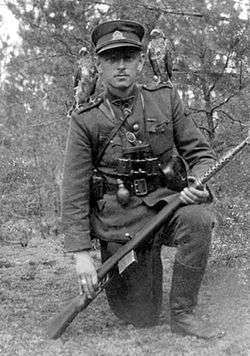Dainava military district
Dainava military district (Dainava partisans military district) is a military district of Lithuanian partisans which operated in 1945–1951 in the counties of Alytus, Lazdijai and Varėna in Dainava (Dzūkija). The most significant battles: on May 17, 1945, in the Kalniškės Forest of the Simnas rural district in the Alytus district (44 partisans killed, about 400 NKVD intruders killed[1]); on June 14, 1945, in the Varčia Forest of the Daugai rural district (40 partisans killed or were arrested, about 176 NKVD intruders were killed[2]). [3]

Adolfas Ramanauskas-Vanagas
Leaders
| Name and surname | Nom de guerre | Since | Till | Comments |
|---|---|---|---|---|
| Juozas Vitkus | Kazimieraitis | 1945 November | 1946 May | |
| Dominykas Jėčys | Ąžuolis | 1946 May | 1947 August | |
| Adolfas Ramanauskas | Vanagas | 1947 August | 1948 September | |
| Benediktas Labėnas | Kariūnas | 1948 September | 1949 March | died in the line of duty |
| Lionginas Baliukevičius | Dzūkas | 1949 May | 1950 June | died in the line of duty |
| Juozas Gegužis | Diemedis | 1950 June | 1951 September | |
| Vincas Daunoras | Ungurys | 1951 September | 1952 May | died in the line of duty |
Structure of Lithuanian partisans' organisation
| LLKS | |||||||||||||||||||||||||||||||||||||||||||||||||||||||||||||||||||||||||
| Western Lithuania (Jūra) region | Southern Lithuania (Nemunas) region | Eastern Lithuania (King Mindaugas) region | |||||||||||||||||||||||||||||||||||||||||||||||||||||||||||||||||||||||
| Žemaičiai military district | Prisikėlimas military district | Kęstutis military district | Tauras military district | Dainava military district | Algimantas military district | Vytautas military district | Vytis military district | Didžioji Kova military district | |||||||||||||||||||||||||||||||||||||||||||||||||||||||||||||||||
| Alka | Maironis | Vaidotas | Vytautas | Dzūkai | Žalioji | Tigras | Krikštaponis | ||||||||||||||||||||||||||||||||||||||||||||||||||||||||||||||||||
| Šatrija | Duke Žvelgaitis | Birutė | Žalgiris | Šarūnas | Šarūnas | Liūtas | Briedis | ||||||||||||||||||||||||||||||||||||||||||||||||||||||||||||||||||
| Kardas | Juozapavičius | Butageidis | Geležinis vilkas | Kazimieraitis | Duke Margiris | Lokys | |||||||||||||||||||||||||||||||||||||||||||||||||||||||||||||||||||
| Lietuvos žalioji | |||||||||||||||||||||||||||||||||||||||||||||||||||||||||||||||||||||||||
Notes and references
- "xxiamzius.lt". Retrieved 15 September 2019.
- "vyr.ltn. V. Daunoravičius. Varčios mūšis. Mūšio schema. Taktika. Išdavos". kurejassavanoris.eu. Retrieved 15 September 2019.
- "The partisan military districts of the Lithuanian freedom fighters". genocid.lt. Retrieved 15 September 2019.
gollark: What muons? You haven't been converted yet.
gollark: Subject to conservation laws.
gollark: If you don't use Us when needed, you may be converted into muons at random or deterministically at our discretion.
gollark: [NEIGHBOURING COUNTRY] sure is bad, due to [MINOR DIFFERENCE].
gollark: Oh. Sure, maybe.
External links
- Genocide and Resistance Research Centre of Lithuania
- The partisan military districts of the Lithuanian freedom fighters
- Vienui Vieni ("Utterly Alone") 2004 film about the Lithuanian Forest Brothers, based on the real life events of Juozas Lukša aka Juozas L. Daumantas
- War Chronicle of the Partisans – Chronicle of Lithuanian partisans, June 1944 – May 1949, prepared by Algis Rupainis
- Forest Brothers – Fight for the Baltics – official YouTube channel of NATO, 2017
This article is issued from Wikipedia. The text is licensed under Creative Commons - Attribution - Sharealike. Additional terms may apply for the media files.